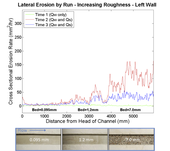Highlight
Lateral bank erosion in bedrock streams
Achievement/Results
Lateral bank erosion in bedrock streams is important in setting boundary conditions for landscape evolution, yet little is known about the controls and mechanisms of this process. We conducted a series of flume experiments with erodible ‘bedrock’ walls to investigate the influence of bed roughness on bank erosion in bedrock channels. Bed roughness was varied along the length of the channel by changing the size of particles embedded in a non-erodible bed material. In addition to varying the size of embedded particles, we varied the downstream trend in bed roughness (increasing, decreasing or alternating). Experiments consisted of an initial time period of clear water flow followed by multiple periods in which 4mm gravel was introduced into the channel at a constant rate. Bank erosion from clear water flow was negligible compared to erosion during periods of gravel supply. Erosion during periods of gravel supply was focused near the base of the channel walls resulting in undercut banks.
Reach-average bank erosion rates in ‘rough’ sections were 3 to 5 times greater than those in control sections (no embedded particles). Within a single experiment, erosion rates in ‘rough’ sections of different embedded particle size and concentration were similar. This similarity suggests that reach-average bank erosion rates are insensitive to increases in bed roughness beyond a threshold value. Our results indicate: 1) impacts by transported gravel particles are a viable mechanism of bank erosion; 2) the presence (or absence) of roughness elements on the bed exerts a control on rates of bank erosion.
Address Goals
An improved understanding of the mechanisms of lateral bank erosion is important to the maintenance of engineering structures located in a river environment. Bridges are a vitally important part of a transportation network and are subject to degradation by lateral river bank erosion. In particular, bridge abutments constructed adjacent to river banks are particularly at risk of degradation due to bank erosion. As a result of these experiments, civil engineers have an improved understanding of the mechanisms of bank erosion. The results of these experiments could result in the implementation of new maintenance methods for existing bridge structures and possibly guide the design and construction of new bridge structures. In addition to this potential benefit to transportation networks, these experiments provide new knowledge which could be used to address one of the fundamental unanswered questions in geomorphology: what determines the width of a channel? The insight into a specific mechanism of channel widening that we provide here may shed new light on how the width of a channel is determined.








